
Concept explainers
(a)
Interpretation:
The IUPAC name of given compound is to be stated.
Concept introduction:
Carboxylic acids are the carbon compounds that contain carboxyl group as a major
The chemical structures are described by IUPAC name or common names. IUPAC names are totally different from common names because IUPAC names are applied at international level and it comprises suffix, prefix, numbers and other priority rules.
(a)
Answer to Problem 20.25SP
The
Explanation of Solution
The chemical structure of the given compound is shown in figure 1.

Figure 1
The structure comprises chain of five carbon atoms along with
Therefore, the
(b)
Interpretation:
The IUPAC name of given compound is to be stated.
Concept introduction:
Carboxylic acids are the carbon compounds that contain carboxyl group as a major functional group. These are polar compounds due to difference in an electronegativity of the atoms in a compound.
The chemical structures are described by IUPAC name or common names. IUPAC names are totally different from common names because IUPAC names are applied at international level and it comprises suffix, prefix, numbers and other priority rules.
(b)
Answer to Problem 20.25SP
The
Explanation of Solution
The chemical structure of the given compound is shown in figure 2.
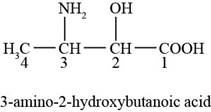
Figure 2
The structure comprises chain of four carbon atoms along with carboxylic acid group, hydroxyl group and amino group at first, second, and third carbon atoms respectively. Carboxylic acid group gets higher priority during the naming of structure because it is present at first carbon atom. According to
Therefore, the
(c)
Interpretation:
The IUPAC name of given compound is to be stated.
Concept introduction:
Carboxylic acids are the carbon compounds that contain carboxyl group as a major functional group. These are polar compounds due to difference in an electronegativity of the atoms in a compound.
The chemical structures are described by IUPAC name or common names. IUPAC names are totally different from common names because IUPAC names are applied at international level and it comprises suffix, prefix, numbers and other priority rules.
(c)
Answer to Problem 20.25SP
The
Explanation of Solution
The chemical structure of the given compound is shown in figure 3.
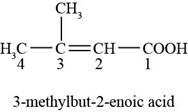
Figure 3
The structure comprises chain of four carbon atoms along with carboxylic acid group and methyl group at first and third carbon atoms respectively. The double bond is present in between the second and third carbon atoms. Carboxylic acid group gets higher priority during the naming of structure because it is present at first carbon atom. According to
Therefore, the
(d)
Interpretation:
The IUPAC name of given compound is to be stated.
Concept introduction:
Carboxylic acids are the carbon compounds that contain carboxyl group as a major functional group. These are polar compounds due to difference in an electronegativity of the atoms in a compound.
The chemical structures are described by IUPAC name or common names. IUPAC names are totally different from common names because IUPAC names are applied at international level and it comprises suffix, prefix, numbers and other priority rules.
(d)
Answer to Problem 20.25SP
The
Explanation of Solution
The chemical structure of the given compound is shown in figure 4.
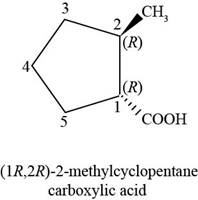
Figure 4
The structure comprises cyclic ring of five carbon atoms along with one group of carboxylic acids at first carbon atom and one methyl group at second carbon atom. The carboxylic acid group is present below the plane, whereas methyl group is present at above the plane. According to
Therefore, the
(e)
Interpretation:
The IUPAC name of given compound is to be stated.
Concept introduction:
Carboxylic acids are the carbon compounds that contain carboxyl group as a major functional group. These are polar compounds due to difference in electronegativity of the atoms in a compound.
The chemical structures are described by IUPAC name or common names. IUPAC names are totally different from common names because IUPAC names are applied at international level and it comprises suffix, prefix, numbers and other priority rules.
(e)
Answer to Problem 20.25SP
The
Explanation of Solution
The chemical structure of the given compound is shown in figure 5.
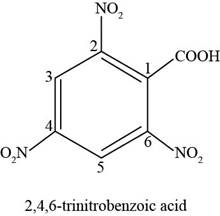
Figure 5
The structure comprises cyclic ring of six carbon atoms along with one carboxylic acid group at first position and three nitro groups at second, fourth and sixth carbon atoms. According to
Therefore, the
(f)
Interpretation:
The IUPAC name of given compound is to be stated.
Concept introduction:
Carboxylic acids are the carbon compounds that contain carboxyl group as a major functional group. These are polar compounds due to difference in electronegativity of the atoms in a compound.
The chemical structures are described by IUPAC name or common names. IUPAC names are totally different from common names because IUPAC names are applied at international level and it comprises suffix, prefix, numbers and other priority rules.
(f)
Answer to Problem 20.25SP
The
Explanation of Solution
The chemical structure of the given compound is shown in figure 6.
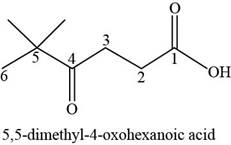
Figure 6
The structure comprises parent chain of six carbon atoms along with carboxylic acid group, carbonyl group, and two methyl groups at first, fourth and fifth carbon atoms respectively. According to
Therefore, the
Want to see more full solutions like this?
Chapter 20 Solutions
Organic Chemistry (9th Edition)
- : Draw the structure of valylasparagine, a dipeptide made from valine and asparagine, as it would appear at physiological pH. Click and drag to start drawing a structure. P Darrow_forwardDraw the Haworth projection of α-L-mannose. You will find helpful information in the ALEKS Data resource. Click and drag to start drawing a structure. : ཊི Х Darrow_forwardDraw the structure of serine at pH 6.8. Click and drag to start drawing a structure. : d كarrow_forward
- Take a look at this molecule, and then answer the questions in the table below it. CH2OH H H H OH OH OH CH2OH H H H H OH H H OH H OH Is this a reducing sugar? yes α β ロ→ロ no ☑ yes Does this molecule contain a glycosidic bond? If you said this molecule does contain a glycosidic bond, write the symbol describing it. O no 0+0 If you said this molecule does contain a glycosidic bond, write the common names (including anomer and enantiomer labels) of the molecules that would be released if that bond were hydrolyzed. If there's more than one molecule, separate each name with a comma. ☐arrow_forwardAnswer the questions in the table below about this molecule: H₂N-CH₂ -C—NH–CH–C—NH–CH—COO- CH3 CH CH3 What kind of molecule is this? 0= CH2 C If you said the molecule is a peptide, write a description of it using 3-letter codes separated ☐ by dashes. polysaccharide peptide amino acid phospolipid none of the above Хarrow_forwardDraw a Haworth projection of a common cyclic form of this monosaccharide: CH₂OH C=O HO H H -OH H OH CH₂OH Click and drag to start drawing a structure. : ☐ Х S '☐arrow_forward
- Nucleophilic Aromatic Substitution 22.30 Predict all possible products formed from the following nucleophilic substitution reactions. (a) (b) 9 1. NaOH 2. HCI, H₂O CI NH₁(!) +NaNH, -33°C 1. NaOH 2. HCl, H₂Oarrow_forwardSyntheses 22.35 Show how to convert toluene to these compounds. (a) -CH,Br (b) Br- -CH3 22.36 Show how to prepare each compound from 1-phenyl-1-propanone. 1-Phenyl-1-propanone ہتی. Br. (b) Br (racemic) 22.37 Show how to convert ethyl benzene to (a) 2,5-dichlorobenzoic acid and (b) 2,4-dichlorobenzoic acid. 22.38 Show reagents and conditions to bring about the following conversions. (a) 9 NH2 8 CO₂H NH2 CO₂Et (d) NO2 NH2 S NH₂ NO2 CHS CHarrow_forwardive the major organic product(s) of each of the following reactions or sequences of reactions. Show all rant stereochemistry. [10 only] A. B. NaN3 1. LiAlH4, ether Br 2. H₂O CH3 HNO3 H₂/Pt H₂SO ethanol C. 0 0 CH3CC1 NaOH NHCCH AICI H₂O . NH₂ CH3CH2 N CH2CH3 + HCI CH₂CH 3 1. LIAIH, THE 2. H₂Oarrow_forward
- Calculate the stoichiometric amount of CaCl2 needed to convert all of the CuSO4 into CuCl2.arrow_forwardH CH تنی Cl 1. NaCN, DMF 2. LIAIH4, ether H₂O pyridine N NH₂ 5 CH H 1 HNO, H₂SO 2. Nal NH2 Br Br HNO₂ CuCl H₂SO HCI CH3 H3C NN HSO KCN CuCN 1. HNO₂, H₂SO O₂N NH2 2. OH ཀ་ལས། །ས་ཅན་ :i་དེ་མ་མ་སེ་ NH₂ CH3 1. HNO₂, H₂SO4 2. H3PO₂ 1 HNO2, H2SO4 2. Nalarrow_forwardive the major organic product(s) of each of the following reactions or sequences of reactions. Show all rant stereochemistry. [10 only] A. B. NaN3 1. LiAlH4, ether Br 2. H₂O CH3 HNO3 H₂/Pt H₂SO ethanol C. 0 0 CH3CC1 NaOH NHCCH AICI H₂O . NH₂ CH3CH2 N CH2CH3 + HCI CH₂CH 3 1. LIAIH, THE 2. H₂Oarrow_forward
- Chemistry: Matter and ChangeChemistryISBN:9780078746376Author:Dinah Zike, Laurel Dingrando, Nicholas Hainen, Cheryl WistromPublisher:Glencoe/McGraw-Hill School Pub Co
